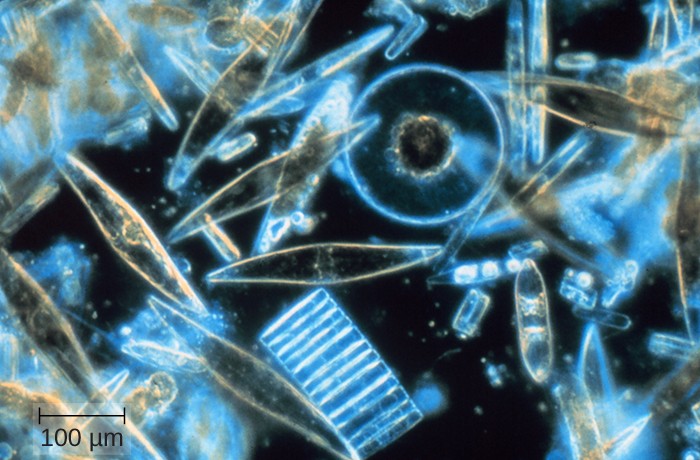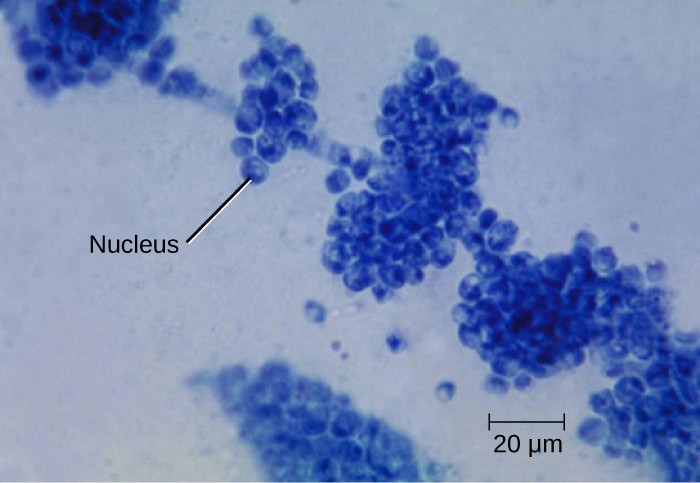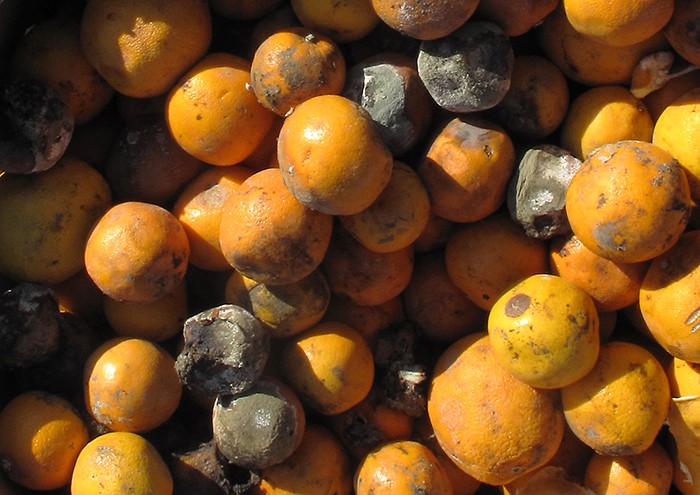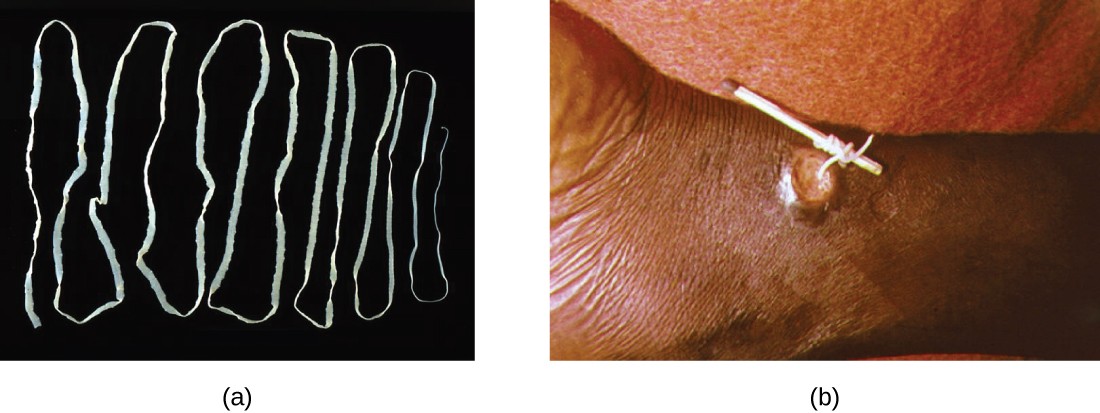What Term Describes All Of The Plants, Animals, Fungi, And Microorganisms In A Forest?
Learning Objectives
- List the diverse types of microorganisms and describe their defining characteristics
- Give examples of different types of cellular and viral microorganisms and infectious agents
- Describe the similarities and differences between archaea and leaner
- Provide an overview of the field of microbiology
Most microbes are unicellular and small enough that they require artificial magnification to be seen. However, there are some unicellular microbes that are visible to the naked eye, and some multicellular organisms that are microscopic. An object must measure out about 100 micrometers (µm) to be visible without a microscope, merely nearly microorganisms are many times smaller than that. For some perspective, consider that a typical animate being prison cell measures roughly ten µm beyond but is however microscopic. Bacterial cells are typically near 1 µm, and viruses tin can be x times smaller than bacteria (Figure i). See Tabular array 1 for units of length used in microbiology.
 Figure 1. The relative sizes of various microscopic and nonmicroscopic objects. Note that a typical virus measures about 100 nm, x times smaller than a typical bacterium (~ane µm), which is at least 10 times smaller than a typical plant or animal prison cell (~ten–100 µm). An object must measure out most 100 µm to be visible without a microscope.
Figure 1. The relative sizes of various microscopic and nonmicroscopic objects. Note that a typical virus measures about 100 nm, x times smaller than a typical bacterium (~ane µm), which is at least 10 times smaller than a typical plant or animal prison cell (~ten–100 µm). An object must measure out most 100 µm to be visible without a microscope.
| Table one. Units of Length Commonly Used in Microbiology | ||
|---|---|---|
| Metric Unit | Significant of Prefix | Metric Equivalent |
| meter (one thousand) | — | i m = 100 1000 |
| decimeter (dm) | one/ten | one dm = 0.1 1000 = 10−ane thousand |
| centimeter (cm) | 1/100 | 1 cm = 0.01 m = 10−2 m |
| millimeter (mm) | 1/1000 | i mm = 0.001 grand = ten−3 chiliad |
| micrometer (μm) | one/ane,000,000 | 1 μm = 0.000001 thou = 10−six m |
| nanometer (nm) | 1/1,000,000,000 | 1 nm = 0.000000001 g = x−9 thousand |
Microorganisms differ from each other non merely in size, but also in structure, habitat, metabolism, and many other characteristics. While nosotros typically think of microorganisms every bit being unicellular, there are also many multicellular organisms that are too small to be seen without a microscope. Some microbes, such as viruses, are even acellular (not composed of cells).
Microorganisms are institute in each of the three domains of life: Archaea, Bacteria, and Eukarya. Microbes inside the domains Bacteria and Archaea are all prokaryotes (their cells lack a nucleus), whereas microbes in the domain Eukarya are eukaryotes (their cells accept a nucleus). Some microorganisms, such equally viruses, do non fall within any of the three domains of life. In this section, we will briefly innovate each of the broad groups of microbes. Later chapters will go into greater depth almost the diverse species within each group.
Prokaryotic Microorganisms
Bacteria are constitute in nearly every habitat on earth, including within and on humans. Well-nigh bacteria are harmless or helpful, merely some are pathogens, causing disease in humans and other animals. Bacteria are prokaryotic because their genetic fabric (Dna) is non housed within a truthful nucleus. Most bacteria have cell walls that contain peptidoglycan.
Bacteria are often described in terms of their general shape. Common shapes include spherical (coccus), rod-shaped (bacillus), or curved (spirillum, spirochete, or vibrio). Figure ii shows examples of these shapes.
 Figure 2. Mutual bacterial shapes. Note how coccobacillus is a combination of spherical (coccus) and rod-shaped (bacillus). (credit "Coccus": modification of work past Janice Haney Carr, Centers for Disease Control and Prevention; credit "Coccobacillus": modification of work past Janice Carr, Centers for Disease Command and Prevention; credit "Spirochete": Centers for Affliction Control and Prevention)
Figure 2. Mutual bacterial shapes. Note how coccobacillus is a combination of spherical (coccus) and rod-shaped (bacillus). (credit "Coccus": modification of work past Janice Haney Carr, Centers for Disease Control and Prevention; credit "Coccobacillus": modification of work past Janice Carr, Centers for Disease Command and Prevention; credit "Spirochete": Centers for Affliction Control and Prevention)
They accept a wide range of metabolic capabilities and can grow in a variety of environments, using different combinations of nutrients. Some bacteria are photosynthetic, such as oxygenic cyanobacteria and anoxygenic green sulfur and green nonsulfur bacteria; these bacteria apply energy derived from sunlight, and fix carbon dioxide for growth. Other types of bacteria are nonphotosynthetic, obtaining their free energy from organic or inorganic compounds in their surround.
Archaea are also unicellular prokaryotic organisms. Archaea and bacteria have different evolutionary histories, equally well as significant differences in genetics, metabolic pathways, and the composition of their jail cell walls and membranes. Unlike most bacteria, archaeal prison cell walls do not contain peptidoglycan, just their cell walls are often equanimous of a similar substance called pseudopeptidoglycan. Similar bacteria, archaea are found in virtually every habitat on earth, fifty-fifty farthermost environments that are very cold, very hot, very basic, or very acidic (Effigy 3). Some archaea live in the homo torso, but none have been shown to be homo pathogens.
 Figure 3. Some archaea alive in farthermost environments, such every bit the Morning Celebrity pool, a hot jump in Yellowstone National Park. The color differences in the pool event from the different communities of microbes that are able to thrive at various water temperatures.
Figure 3. Some archaea alive in farthermost environments, such every bit the Morning Celebrity pool, a hot jump in Yellowstone National Park. The color differences in the pool event from the different communities of microbes that are able to thrive at various water temperatures.
Think virtually It
- What are the 2 main types of prokaryotic organisms?
- Name some of the defining characteristics of each type.
Eukaryotic Microorganisms
The domain Eukarya contains all eukaryotes, including uni- or multicellular eukaryotes such as protists, fungi, plants, and animals. The major defining feature of eukaryotes is that their cells contain a nucleus.
Protists
Protists are unicellular eukaryotes that are non plants, animals, or fungi. Algae and protozoa are examples of protists.
 Figure four. Assorted diatoms, a kind of algae, live in annual sea ice in McMurdo Sound, Antarctica. Diatoms range in size from 2 μm to 200 μm and are visualized here using calorie-free microscopy. (credit: modification of work by National Oceanic and Atmospheric Assistants)
Figure four. Assorted diatoms, a kind of algae, live in annual sea ice in McMurdo Sound, Antarctica. Diatoms range in size from 2 μm to 200 μm and are visualized here using calorie-free microscopy. (credit: modification of work by National Oceanic and Atmospheric Assistants)
Algae (atypical: alga) are plant-like protists that can be either unicellular or multicellular (Figure four). Their cells are surrounded by cell walls fabricated of cellulose, a type of carbohydrate. Algae are photosynthetic organisms that extract energy from the sunday and release oxygen and carbohydrates into their environs. Because other organisms can use their waste products for energy, algae are important parts of many ecosystems. Many consumer products contain ingredients derived from algae, such as carrageenan or alginic acrid, which are found in some brands of ice cream, salad dressing, beverages, lipstick, and toothpaste. A derivative of algae also plays a prominent role in the microbiology laboratory. Agar, a gel derived from algae, can be mixed with various nutrients and used to grow microorganisms in a Petri dish. Algae are also being adult every bit a possible source for biofuels.
Protozoa (singular: protozoan) are protists that make up the backbone of many food webs past providing nutrients for other organisms. Protozoa are very various. Some protozoa motion with aid from pilus-similar structures called cilia or whip-like structures called flagella. Others extend function of their cell membrane and cytoplasm to propel themselves frontwards. These cytoplasmic extensions are called pseudopods ("false feet"). Some protozoa are photosynthetic; others feed on organic textile. Some are costless-living, whereas others are parasitic, only able to survive by extracting nutrients from a host organism. Most protozoa are harmless, but some are pathogens that tin crusade illness in animals or humans (Figure v).
 Figure 5. Giardia lamblia, an intestinal protozoan parasite that infects humans and other mammals, causing severe diarrhea. (credit: modification of work by Centers for Disease Control and Prevention)
Figure 5. Giardia lamblia, an intestinal protozoan parasite that infects humans and other mammals, causing severe diarrhea. (credit: modification of work by Centers for Disease Control and Prevention)
Fungi
Fungi (singular: fungus) are also eukaryotes. Some multicellular fungi, such as mushrooms, resemble plants, but they are really quite dissimilar. Fungi are not photosynthetic, and their cell walls are unremarkably made out of chitin rather than cellulose.
 Figure six. Candida albicans is a unicellular fungus, or yeast. It is the causative agent of vaginal yeast infections as well as oral thrush, a yeast infection of the mouth that unremarkably afflicts infants. C. albicans has a morphology similar to that of coccus bacteria; yet, yeast is a eukaryotic organism (note the nuclei) and is much larger. (credit: modification of work by Centers for Disease Command and Prevention)
Figure six. Candida albicans is a unicellular fungus, or yeast. It is the causative agent of vaginal yeast infections as well as oral thrush, a yeast infection of the mouth that unremarkably afflicts infants. C. albicans has a morphology similar to that of coccus bacteria; yet, yeast is a eukaryotic organism (note the nuclei) and is much larger. (credit: modification of work by Centers for Disease Command and Prevention)
Unicellular fungi—yeasts—are included within the written report of microbiology. At that place are more than grand known species. Yeasts are institute in many different environments, from the deep ocean to the human being bellybutton. Some yeasts have beneficial uses, such as causing bread to rise and beverages to ferment; but yeasts can also cause food to spoil. Some even cause diseases, such as vaginal yeast infections and oral thrush (Figure vi).
Other fungi of interest to microbiologists are multicellular organisms chosen molds. Molds are made up of long filaments that grade visible colonies (Figure 7). Molds are found in many unlike environments, from soil to rotting nutrient to dank bathroom corners. Molds play a disquisitional role in the decomposition of expressionless plants and animals. Some molds can cause allergies, and others produce disease-causing metabolites called mycotoxins. Molds accept been used to make pharmaceuticals, including penicillin, which is ane of the nigh ordinarily prescribed antibiotics, and cyclosporine, used to prevent organ rejection following a transplant.
 Effigy seven. Large colonies of microscopic fungi can frequently be observed with the naked centre, as seen on the surface of these moldy oranges.
Effigy seven. Large colonies of microscopic fungi can frequently be observed with the naked centre, as seen on the surface of these moldy oranges.
Think about It
- Name two types of protists and ii types of fungi.
- Proper name some of the defining characteristics of each type.
Helminths
Multicellular parasitic worms called helminths are not technically microorganisms, as almost are big enough to run into without a microscope. Still, these worms fall within the field of microbiology considering diseases caused by helminths involve microscopic eggs and larvae. One instance of a helminth is the guinea worm, or Dracunculus medinensis, which causes dizziness, vomiting, diarrhea, and painful ulcers on the legs and anxiety when the worm works its way out of the skin (Figure 8). Infection typically occurs after a person drinks water containing water fleas infected by guinea-worm larvae. In the mid-1980s, there were an estimated 3.5 million cases of guinea-worm disease, but the disease has been largely eradicated. In 2014, in that location were just 126 cases reported, thanks to the coordinated efforts of the World Health Organization (WHO) and other groups committed to improvements in drinking water sanitation.[10]
 Figure eight. (a) The beef tapeworm, Taenia saginata, infects both cattle and humans. T. saginata eggs are microscopic (around 50 µm), but developed worms like the one shown here tin reach iv–10 m, taking upward residence in the digestive system. (b) An developed guinea worm, Dracunculus medinensis, is removed through a lesion in the patient's skin by winding it around a matchstick. (credit a, b: modification of work past Centers for Disease Control and Prevention)
Figure eight. (a) The beef tapeworm, Taenia saginata, infects both cattle and humans. T. saginata eggs are microscopic (around 50 µm), but developed worms like the one shown here tin reach iv–10 m, taking upward residence in the digestive system. (b) An developed guinea worm, Dracunculus medinensis, is removed through a lesion in the patient's skin by winding it around a matchstick. (credit a, b: modification of work past Centers for Disease Control and Prevention)
Viruses
Viruses are acellular microorganisms, which means they are not composed of cells. Essentially, a virus consists of proteins and genetic material—either DNA or RNA, but never both—that are inert outside of a host organism. All the same, past incorporating themselves into a host cell, viruses are able to co-opt the host'south cellular mechanisms to multiply and infect other hosts.
Viruses can infect all types of cells, from homo cells to the cells of other microorganisms. In humans, viruses are responsible for numerous diseases, from the mutual common cold to mortiferous Ebola (Effigy 9). Even so, many viruses do not cause illness.
 Effigy ix. (a) Members of the Coronavirus family can cause respiratory infections like the mutual cold, severe astute respiratory syndrome (SARS), and Middle Due east respiratory syndrome (MERS). Here they are viewed under a transmission electron microscope (TEM). (b) Ebolavirus, a member of the Filovirus family, as visualized using a TEM. (credit a: modification of work by Centers for Disease Control and Prevention; credit b: modification of work by Thomas W. Geisbert)
Effigy ix. (a) Members of the Coronavirus family can cause respiratory infections like the mutual cold, severe astute respiratory syndrome (SARS), and Middle Due east respiratory syndrome (MERS). Here they are viewed under a transmission electron microscope (TEM). (b) Ebolavirus, a member of the Filovirus family, as visualized using a TEM. (credit a: modification of work by Centers for Disease Control and Prevention; credit b: modification of work by Thomas W. Geisbert)
Remember about It
- Are helminths microorganisms? Explain why or why not.
- How are viruses dissimilar from other microorganisms?
 Effigy 10. A virologist samples eggs from this nest to be tested for the influenza A virus, which causes avian influenza in birds. (credit: U.Southward. Fish and Wild animals Service)
Effigy 10. A virologist samples eggs from this nest to be tested for the influenza A virus, which causes avian influenza in birds. (credit: U.Southward. Fish and Wild animals Service)
Microbiology as a Discipline
Microbiology is a broad term that encompasses the report of all different types of microorganisms. But in practice, microbiologists tend to specialize in one of several subfields. For example, bacteriology is the study of bacteria; mycology is the written report of fungi; protozoology is the study of protozoa; parasitology is the study of helminths and other parasites; and virology is the study of viruses (Figure 10).
Immunology, the study of the allowed organisation, is often included in the study of microbiology because host–pathogen interactions are central to our understanding of infectious disease processes. Microbiologists tin can likewise specialize in certain areas of microbiology, such as clinical microbiology, ecology microbiology, applied microbiology, or food microbiology.
In this textbook, nosotros are primarily concerned with clinical applications of microbiology, but since the diverse subfields of microbiology are highly interrelated, we will often hash out applications that are not strictly clinical.
Bioethics in Microbiology
In the 1940s, the U.S. government was looking for a solution to a medical trouble: the prevalence of sexually transmitted diseases (STDs) among soldiers. Several now-infamous government-funded studies used human subjects to research mutual STDs and treatments. In one such written report, American researchers intentionally exposed more than 1300 human subjects in Guatemala to syphilis, gonorrhea, and chancroid to determine the ability of penicillin and other antibiotics to combat these diseases. Subjects of the study included Guatemalan soldiers, prisoners, prostitutes, and psychiatric patients—none of whom were informed that they were taking role in the report. Researchers exposed subjects to STDs by various methods, from facilitating intercourse with infected prostitutes to inoculating subjects with the bacteria known to cause the diseases. This latter method involved making a small-scale wound on the subject field's genitals or elsewhere on the body, and and so putting bacteria directly into the wound. [11] In 2011, a U.S. government commission tasked with investigating the experiment revealed that merely some of the subjects were treated with penicillin, and 83 subjects died by 1953, likely as a consequence of the study.[12]
Unfortunately, this is ane of many horrific examples of microbiology experiments that have violated basic ethical standards. Even if this written report had led to a life-saving medical breakthrough (it did not), few would argue that its methods were ethically sound or morally justifiable. Simply not every case is then articulate cut. Professionals working in clinical settings are oftentimes confronted with ethical dilemmas, such as working with patients who decline a vaccine or life-saving blood transfusion. These are but two examples of life-and-death decisions that may intersect with the religious and philosophical beliefs of both the patient and the health-intendance professional.
No matter how noble the goal, microbiology studies and clinical practice must exist guided by a certain fix of upstanding principles. Studies must exist done with integrity. Patients and research subjects provide informed consent (non merely agreeing to be treated or studied only demonstrating an understanding of the purpose of the study and any risks involved). Patients' rights must be respected. Procedures must be approved past an institutional review board. When working with patients, accurate record-keeping, honest communication, and confidentiality are paramount. Animals used for inquiry must be treated humanely, and all protocols must be canonical by an institutional animal care and use committee. These are but a few of the ethical principles explored in the Middle on Ethics boxes throughout this book.
Clinical Focus: Cora, Resolution
This example concludes Cora's story that started in What Our Ancestors Knew and A Systematic Approach.
Cora's CSF samples show no signs of inflammation or infection, every bit would be expected with a viral infection. Even so, there is a high concentration of a particular protein, 14-three-3 protein, in her CSF. An electroencephalogram (EEG) of her brain function is also aberrant. The EEG resembles that of a patient with a neurodegenerative disease like Alzheimer's or Huntington's, just Cora'due south rapid cognitive decline is not consequent with either of these. Instead, her doctor concludes that Cora has Creutzfeldt-Jakob affliction (CJD), a type of transmissible spongiform encephalopathy (TSE).
CJD is an extremely rare affliction, with only about 300 cases in the United States each year. It is not acquired by a bacterium, fungus, or virus, just rather past prions—which do non fit neatly into any particular category of microbe. Like viruses, prions are non establish on the tree of life considering they are acellular. Prions are extremely small, about one-tenth the size of a typical virus. They contain no genetic textile and are equanimous solely of a type of abnormal protein.
CJD can have several different causes. It tin be acquired through exposure to the brain or nervous-organization tissue of an infected person or brute. Consuming meat from an infected brute is one way such exposure can occur. At that place have also been rare cases of exposure to CJD through contact with contaminated surgical equipment[13][14] and from cornea and growth-hormone donors who unknowingly had CJD.[15][xvi] In rare cases, the illness results from a specific genetic mutation that can sometimes be hereditary. However, in approximately 85% of patients with CJD, the cause of the illness is spontaneous (or sporadic) and has no identifiable crusade.[17] Based on her symptoms and their rapid progression, Cora is diagnosed with sporadic CJD.
Unfortunately for Cora, CJD is a fatal disease for which there is no approved treatment. Approximately xc% of patients die within 1 twelvemonth of diagnosis.[18] Her doctors focus on limiting her hurting and cognitive symptoms equally her disease progresses. Eight months subsequently, Cora dies. Her CJD diagnosis is confirmed with a brain autopsy.
Key Concepts and Summary
- Microorganisms are very diverse and are plant in all three domains of life: Archaea, Leaner, and Eukarya.
- Archaea and leaner are classified as prokaryotes because they lack a cellular nucleus. Archaea differ from bacteria in evolutionary history, genetics, metabolic pathways, and jail cell wall and membrane composition.
- Archaea inhabit nearly every environment on earth, but no archaea have been identified as human pathogens.
- Eukaryotes studied in microbiology include algae, protozoa, fungi, and helminths.
- Algae are plant-like organisms that can be either unicellular or multicellular, and derive energy via photosynthesis.
- Protozoa are unicellular organisms with complex jail cell structures; near are motile.
- Microscopic fungi include molds and yeasts.
- Helminths are multicellular parasitic worms. They are included in the field of microbiology considering their eggs and larvae are often microscopic.
- Viruses are acellular microorganisms that require a host to reproduce.
- The field of microbiology is extremely broad. Microbiologists typically specialize in i of many subfields, but all health professionals demand a solid foundation in clinical microbiology.
Multiple Selection
Which of the post-obit types of microorganisms is photosynthetic?
- yeast
- virus
- helminth
- algae
Prove Answer
Answer d. Algae is photosynthetic.
Which of the following is a prokaryotic microorganism?
- helminth
- protozoan
- cyanobacterium
- mold
Show Answer
Answer c. Cyanobacterium is a prokaryotic microorganism.
Which of the following is acellular?
- virus
- bacterium
- mucus
- protozoan
Show Reply
Answer a. Viruses are acellular.
Which of the following is a type of fungal microorganism?
- bacterium
- protozoan
- alga
- yeast
Show Answer
Respond d. Yeast is a type of fungal microorganism.
Which of the post-obit is not a subfield of microbiology?
- bacteriology
- botany
- clinical microbiology
- virology
Show Answer
Respond b. Botany is not a subfield of microbiology.
Make full in the Blank
A ________ is a disease-causing microorganism.
Evidence Reply
A pathogen is a disease-causing microorganism.
Multicellular parasitic worms studied past microbiologists are called ___________.
Bear witness Answer
Multicellular parasitic worms studied past microbiologists are called helminths.
The study of viruses is ___________.
Testify Respond
The study of viruses is virology.
The cells of prokaryotic organisms lack a _______.
Show Answer
The cells of prokaryotic organisms lack a nucleus.
Recall near It
- Describe the differences between bacteria and archaea.
- Proper name three structures that various protozoa use for locomotion.
- Describe the actual and relative sizes of a virus, a bacterium, and a found or animal cell.
- Contrast the behavior of a virus outside versus within a prison cell.
- Where would a virus, bacterium, fauna cell, and a prion vest on this chart?

Licenses and Attributions
Source: https://www.coursehero.com/study-guides/microbiology/types-of-microorganisms/
Posted by: karlsonopli1944.blogspot.com

0 Response to "What Term Describes All Of The Plants, Animals, Fungi, And Microorganisms In A Forest?"
Post a Comment